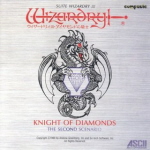Wizardry Suite III -Knight of Diamonds-
 |
Album Title: Wizardry Suite III -Knight of Diamonds- |
| Record Label: Apollon |
|
| Catalog No.: APCG-4003 |
|
| Release Date: April 21, 1990 |
|
| Purchase: Buy Used Copy |
Overview
Wizardry III is the third release of Wizardry arrangement albums. The album was released in 1990 by Appolon, the same publisher that released the Dragon Quest piano albums and the early suites. Wizardry II: Knight of Diamonds was released for NES in 1986 after being initially made for a variety of early computers. Contrary to the limited ability of NES sound driver could produce, the Wizardry series still featured very good classically-oriented music from Kentaro Haneda. This album consists of 12 tracks containing very fine arrangement of original Wizardry music mostly in Baroque style. There is no real change in synthesizer’s quality compared to the previous two. Despite the enjoyable tunes offered by this album, listeners would probably be disappointed with the mediocre quality of the instrument.
Body
Haneda’s composition in this album somehow influenced by Bach. Obviously, if you listen to 0:41 of “Knight of Diamonds -Opening Theme-“, you will see what I mean. This part uses counterpoint like Bach’s famous organ Fugue in D Minor (BWV 565). This track becomes more dramatic halfway through and ends with a grandiose closure. It’s a prelude to an epic story of knights and chivalry. As for the second track, “Llylgamyn Castle” is led by a synthesized harpsichord and organ continuo. This piece progresses slowly and smoothly. The atmosphere of the music is quite gloomy, but overall, it’s pleasant.
The next track is the most eccentric arrangement on this album, “Gilgamesh’s Tavern Third Scene”. I personally think this is one of the most confusing tracks in the whole album and my first impression was that it was totally bizarre. Compared to the original version, the arrangement features much dissonance. The opening of this music uses a very weird synthesizer, which resembles distorted harpsichord or some sort of tuned percussion. Still, as I’ve listen to it more, I began to appreciate it; this track is very cozy and still resembles the original version.
The next track, “Adventurer’s Inn III”, is slow music that resembles a lullaby. It is probably the sweetest and most enjoyable arrangement in this album. This arrangement is good, and the piano accompaniment at 2:24 creates a dramatic and cinematic progression from the gorgeous main theme. This track is a light-hearted trio in a syncopated tempo. It opens with woodwinds and comical phrases, then cosiness is created after the strings are plucked and the flute begin to dance. I swear I could listen to this track looped for hours. It is almost flawless.
As we reach the halfway point of the album, “Temple of Cant III” plays. This track is one of the slowest, dominated by harpsichord use, and intends to create the atmosphere of a church. This is my least favorite track compared to the others. “At Edge of Town” is comical music; the synthesized violin takes the lead and I got the impression of the heroes walking towards the gate of the town, preparing themselves to enter dungeons. This track also resembles to ninth track, “In a Camp”, though the latter is much more rhythmical and jazzy. As for the game over music “No One is Alive -Exterminated-“, this is probably the gloomiest track and uses a synthesized low-quality chorus to give listeners the creeps.
There are two tracks that ruin the medieval mood of this album that has built up since the opening. “Fighting Theme” and “Knight of Diamonds -Ending Theme-” are the only tracks that use percussion and electric guitar, contrary to the rest of tracks that mainly use the synthesizer. The tracks are actually good. The fighting music is a fine and enjoyable in term of musicality. The same also goes for the ending theme; its guitar part shows a certain virtuosity and ends this album on a different note. It’s witty, but still good.
Summary
Generaly, this album is fine. It has potential to be comparable to the Dragon Quest Symphonic Suites but ended up so-so. At the beginning of the album, there are many varied arrangements — tge dramatic opening, the lullaby-like inn music, and the cosy style of Boltac’s trading post that suddenly changed into eighties’ style mood.
The musicality in this album is rich, even epic. These who love classically-style composition like the ones in Dragon Quest’s would probably enjoy this one, you might even notice slight influence of Sugiyama’s dissonant style in Dungeon’s Theme arrangement. These who are not used to listen synthesizer would probably need time to appreciate Haneda’s composition. In the end, his compositions much more suitable to be performed in chamber music or real orchestra instead of mediocre quality synthesizer, which is probably, the biggest flaw overall.
Do you agree with the review and score? Let us know in the comments below!
4
Posted on August 1, 2012 by Calvin Sidjaja. Last modified on August 1, 2012.














